The Flight Pattern of Navel Orangeworm (Amyelois transitella Walker) 2008–2023 in California Pistachio
Simple Summary
Abstract
1. Introduction
2. Materials and Methods
2.1. Study Locations
2.2. Lure and Trap Types
2.3. Degree Day Calculation
2.4. Graphing the Start and End Points and Determining the Flight Intervals
2.5. Validation
2.6. Type of Lures Used and Data Grouping
3. Results
4. Discussion
Funding
Data Availability Statement
Acknowledgments
Conflicts of Interest
References
- Almonds. 2023. Available online: https://www.almonds.com (accessed on 10 September 2024).
- Statista. 2023. Available online: https://www.statista.com/statistics/933042/global-pistachio-production-by-country/ (accessed on 29 August 2024).
- American Committee for Pistachios. 2023. Available online: https://americanpistachios.org (accessed on 10 August 2024).
- Palumbo, J.D.; Mahoney, N.E.; Light, D.M.; Siegel, J.P.; Puckett, R.D.; Michailides, T.J. Spread of Aspergillus flavus by navel orangeworm (Amyelois transitella) on almond. Plant Dis. 2014, 98, 1194–1199. [Google Scholar] [CrossRef] [PubMed]
- Ampt, E.A.; Bush, D.S.; Siegel, J.P.; Berenbaum, M.R. Larval preference and performance of Amyelois transitella (Navel Orangeworm, Lepidoptera: Pyralidae) in relation to the fungus Aspergillus flavus. Environ. Entomol. 2016, 45, 155–162. [Google Scholar] [CrossRef] [PubMed]
- Picot, A.; Ortega-Beltran, A.; Puckett, R.D.; Siegel, J.P.; Michailides, T.J. Period of susceptibility of almonds to aflatoxin contamination during development in the orchard. Eur. J. Plant Pathol. 2017, 148, 521–531. [Google Scholar] [CrossRef]
- Bush, D.S.; Lawrance, A.; Siegel, J.P.; Berenbaum, M.R. Orientation of navel orangeworm (Lepidoptera: Pyralidae) larvae and adults toward volatiles associated with almond hull split and Aspergillus flavus. Environ. Entomol. 2017, 46, 602–608. [Google Scholar] [CrossRef]
- Kuenen, L.P.S.; Siegel, J.P. Protracted emergence of overwintering Amyelois transitella (Lepidoptera: Pyralidae) from pistachios and almonds in California. Environ. Entomol. 2010, 39, 1059–1067. [Google Scholar] [CrossRef]
- Siegel, J.P.; Kuenen, L.P.S.; Ledbetter, C. Variable development rate and survival of navel orangeworm (Lepidoptera: Pyralidae) on wheat bran diet and almonds. J. Econ. Entomol. 2010, 103, 1250–1257. [Google Scholar] [CrossRef]
- Siegel, J.P.; Kuenen, L.P.S. Variable development rate and survival of navel orangeworm (Lepidoptera: Pyralidae) on pistachio. J. Econ. Entomol. 2011, 104, 532–539. [Google Scholar] [CrossRef]
- Siegel, J.P.; Gilcrease, G. Augmenting sanitation with insecticides to improve control of navel orangeworm (Amyelois transitella Walker) (Lepidoptera: Pyralidae) in California tree nuts. Pest Manag. Sci. 2022, 78, 2034–2042. [Google Scholar] [CrossRef]
- Andrews, K.L.; Barnes, M.M. Invasion of pistachio orchards by navel orangeworm moths from almond orchards. Environ. Entomol. 1982, 11, 278–279. [Google Scholar] [CrossRef]
- Higbee, B.S.; Siegel, J.P. Field efficacy and application timing of methoxyfenozide, a reduced-risk treatment for control of navel orangeworm (Lepidoptera: Pyralidae) in almond. J. Econ. Entomol. 2012, 105, 1702–1711. [Google Scholar] [CrossRef]
- Sappington, T.W.; Burks, C.S. Patterns of flight behavior and capacity of unmated navel orangeworm (Lepidoptera: Pyralidae) adults related to age, gender, and wing size. Environ. Entomol. 2014, 43, 696–705. [Google Scholar] [CrossRef] [PubMed][Green Version]
- Reger, J.; Wenger, J.A.; Brar, G.; Burks, C.; Wilson, H. Evaluating flight performance of mass-reared and irradiated navel orangeworm (Lepidoptera: Pyralidae) for sterile insect technique. J. Econ. Entomol. 2021, 114, 1542–1548. [Google Scholar] [CrossRef]
- Wilson, H.; Burks, C.S.; Reger, J.E.; Wenger, J.A. Biology and management of navel orangeworm (Lepidoptera: Pyralidae) in California. J. Integr. Pest Manag. 2020, 25, 1–15. [Google Scholar] [CrossRef]
- Rice, R.E.; Sadler, L.L.; Hoffmann, M.L.; Jones, R.A. Egg traps for the navel orangeworm, Paramyelois transitella (Walker). Environ. Entomol. 1976, 5, 697–700. [Google Scholar] [CrossRef]
- Van Steenwyk, R.K.; Barnett, W.W. Improvements of navel orangeworm (Lepidoptera: Pyralidae) egg traps. J. Econ. Entomol. 1985, 78, 282–286. [Google Scholar] [CrossRef]
- Leal, W.S.; Parra-Pedrazzoli, A.L.; Kaissling, K.E.; Morgan, T.I.; Zalom, F.G.; Pesak, D.J.; Dundulis, E.A.; Burks, C.S.; Higbee, B.S. Unusual pheromone chemistry in the navel orangeworm: Novel sex attractants and a behavioral antagonist. Naturwissenschaften 2005, 92, 139–146. [Google Scholar] [CrossRef]
- Kanno, H.; Kuenen, L.P.S.; Klingler, L.; Millar, J.; Cardé, R. Attractiveness of a four-component pheromone blend to male navel orangeworm moths. J. Chem. Ecol. 2010, 36, 584–591. [Google Scholar] [CrossRef] [PubMed]
- Higbee, B.S.; Burks, C.S.; Larsen, T.E. Demonstration and characterization of a persistent pheromone lure for the navel orangeworm, Amyelois transitella (Lepidoptera: Pyralidae). Insects 2014, 5, 596–600. [Google Scholar] [CrossRef] [PubMed]
- Burks, C.S. Combination phenyl propionate/pheromone traps for monitoring navel orangeworm (Lepidoptera: Pyralidae) in almonds in the vicinity of mating disruption. J. Econ. Entomol. 2017, 110, 438–446. [Google Scholar] [CrossRef]
- Price, D.W.; Mazrimas, J.A.; Summers, F.M. Chemical Attractants for Navel Orangeworm Moths. Calif. Agric. 1967, 21, 10–11. [Google Scholar]
- Burks, C.S.; Kuenen, L.S.; Daane, K.M. Phenyl propionate and sex pheromone for monitoring navel orangeworm (Lepidoptera: Pyralidae) in the presence of mating disruption. J. Econ. Entomol. 2016, 109, 958–961. [Google Scholar] [CrossRef] [PubMed][Green Version]
- Burks, C.S.; Higbee, B.S.; Beck, J.J. Traps and attractants for monitoring navel orangeworm (Lepidoptera: Pyralidae) in the presence of mating disruption. J. Econ. Entomol. 2020, 113, 1270–1278. [Google Scholar] [CrossRef] [PubMed]
- Siegel, J.P.; Burks, C.S.; Wilson, H. Season-long comparison of trap lures for integrated management of the navel orangeworm (Lepidoptera: Pyralidae) in almond and pistachio. CABI Agric. Biosci. 2024, 5, 30. [Google Scholar] [CrossRef]
- Siegel, J.P.; Strmiska, M.; Niederholzer, F.J.A.; Giles, D.K. Evaluating insecticide coverage in almond and pistachio for control of navel orangeworm (Amyelois transitella) (Lepidoptera: Pyralidae). Pest Manag. Sci. 2018, 75, 1435–1442. [Google Scholar] [CrossRef] [PubMed]
- Siegel, J.P.; Strmiska, M.; Walse, S.S. Evaluating insecticide coverage and determining its effect on the duration of control for navel orangeworm (Amyelois transitella Walker) (Lepidoptera: Pyralidae) in California almonds. Pest Manag. Sci. 2019, 75, 2989–2995. [Google Scholar] [CrossRef]
- Haviland, D.R.; Baldwin, R.; Hembree, K.; Michailides, T.; Westerdahl, B.; Beede, R.; Daane, K.; Fukuda, T.; Kallsen, C.; Shrestha, A.; et al. UC IPM Pest Management Guidelines: Pistachio. University of California Agriculture and Natural Resources: Davis, CA, USA, 2022. [Google Scholar]
- Siegel, J.P. Nut factors associated with navel orangeworm, Amyelois transitella (Lepidoptera: Pyralidae) damage to pistachio (Pistacia vera) in California (2007–2017) and implication for control. J. Econ. Entomol. 2023, 116, 882–890. [Google Scholar] [CrossRef]
- Pathak, T.B.; Mahesh, M.L.; Rijal, J.P. Impact of climate change on navel orangeworm, a major pest of tree nuts in California. Sci. Total Environ. 2021, 755 Part 1, 142657. [Google Scholar] [CrossRef]
- Kuenen, L.P.S.; Siegel, J.P. Sticky traps saturate with navel orangeworm in a nonlinear fashion. Calif. Agric. 2016, 70, 32–38. [Google Scholar] [CrossRef]
- Doster, M.; Michailides, T.J. The development of early split pistachio nuts and their contamination by molds, aflatoxins, and insects. Acta Hortic. 1995, 419, 359–364. [Google Scholar] [CrossRef]
- Rosenheim, J.A.; Higbee, B.S.; Ackerman, J.D.; Meisner, M.H. Predicting nut damage at harvest using different in-season density estimates of Amyelois transitella: Analysis of data from commercial almond production. J. Econ. Entomol. 2017, 110, 2692–2698. [Google Scholar] [CrossRef]
- Almond Board of California. 2023. Available online: https://www.almonds.com/about-us/press-room/california-almond-acreage-drops-again-2023#:~:text=Total%20acreage%20dropped%20from%20just,at%20this%20time%20last%20year (accessed on 1 September 2024).
- National Agricultural Statistics Service. 2009. Available online: https://www.nass.usda.gov/Statistics_by_State/California/Publications/Specialty_and_Other_Releases/Almond/Acreage/200905almac.pdf (accessed on 1 September 2024).
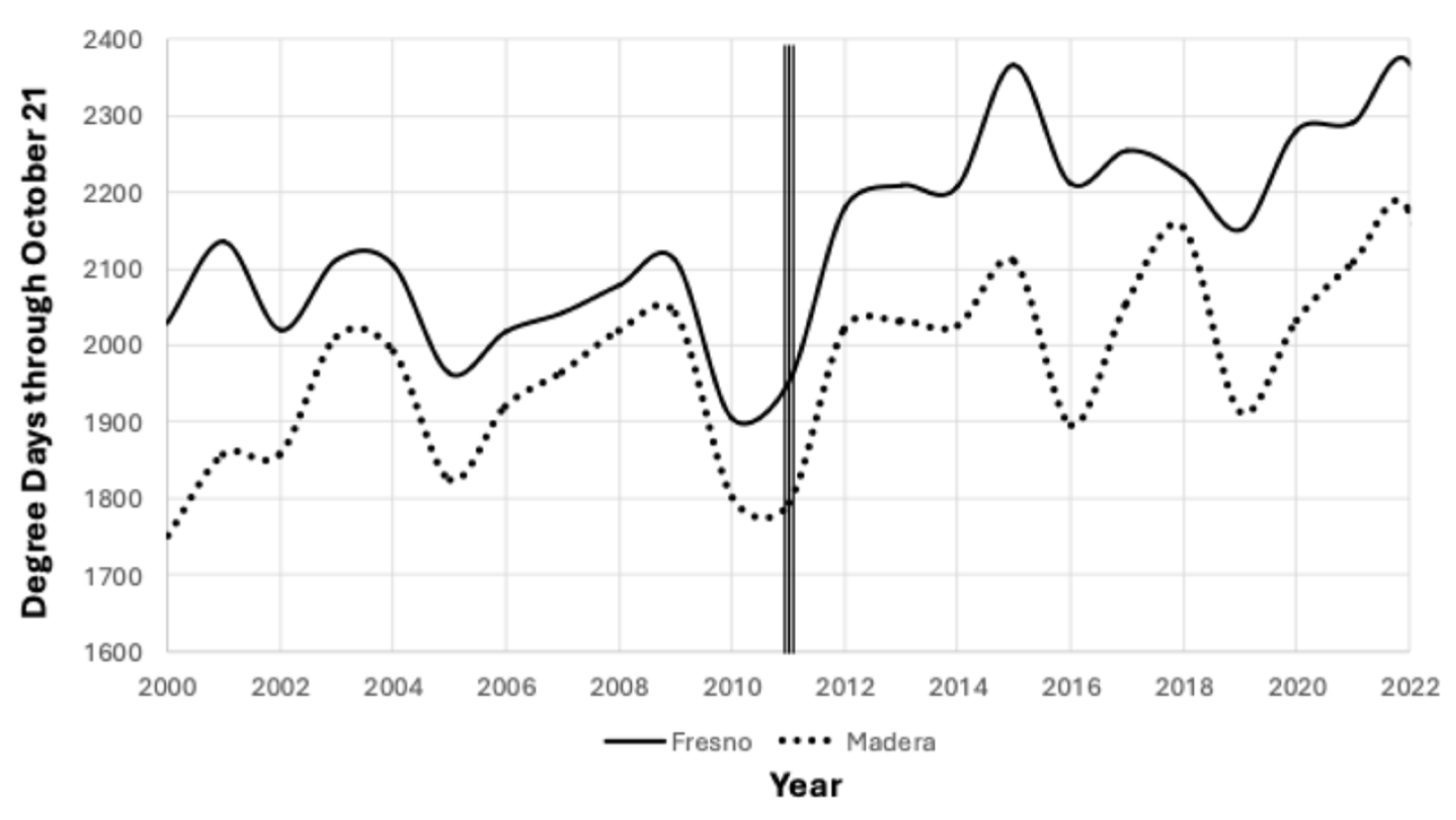
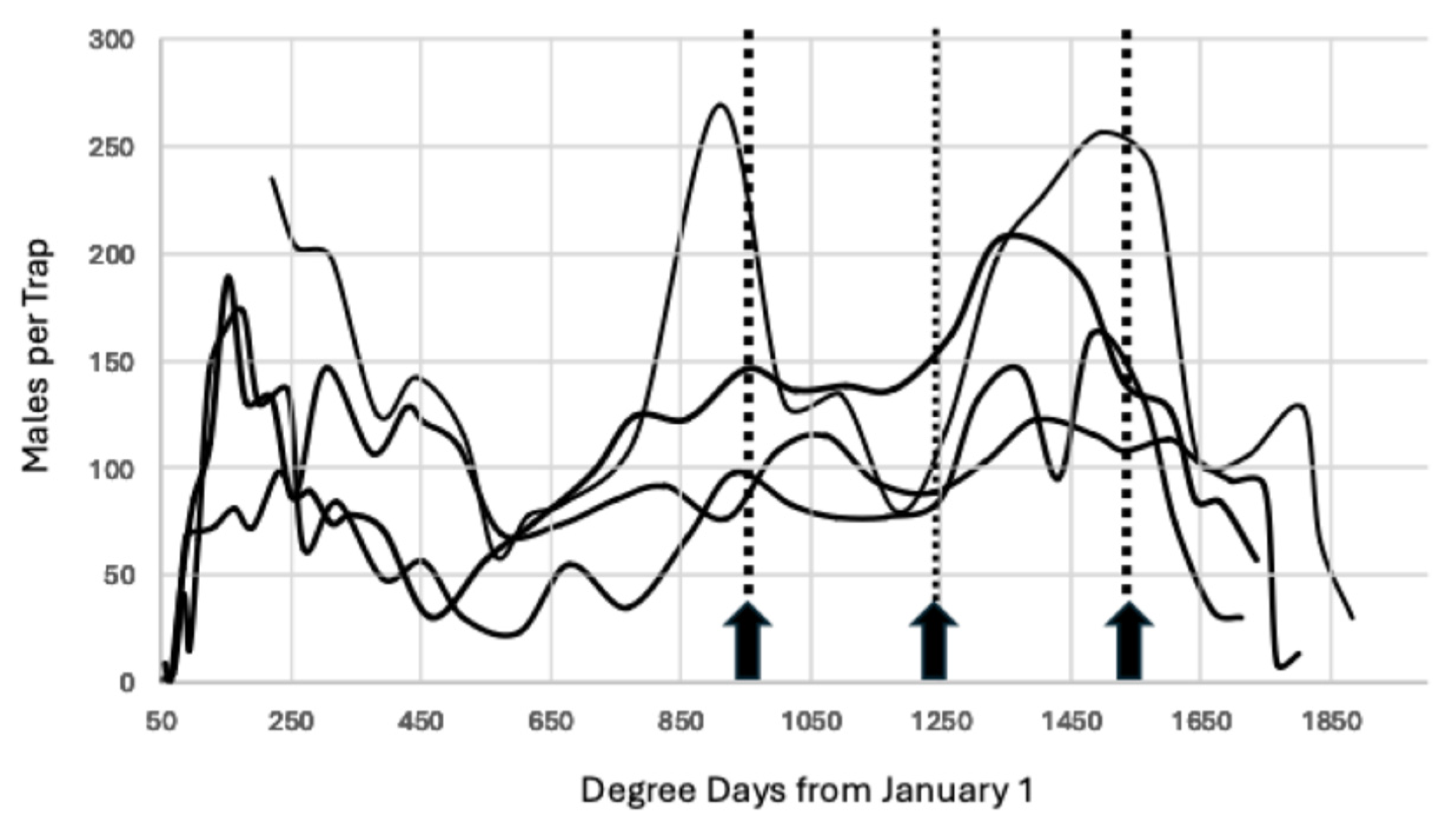

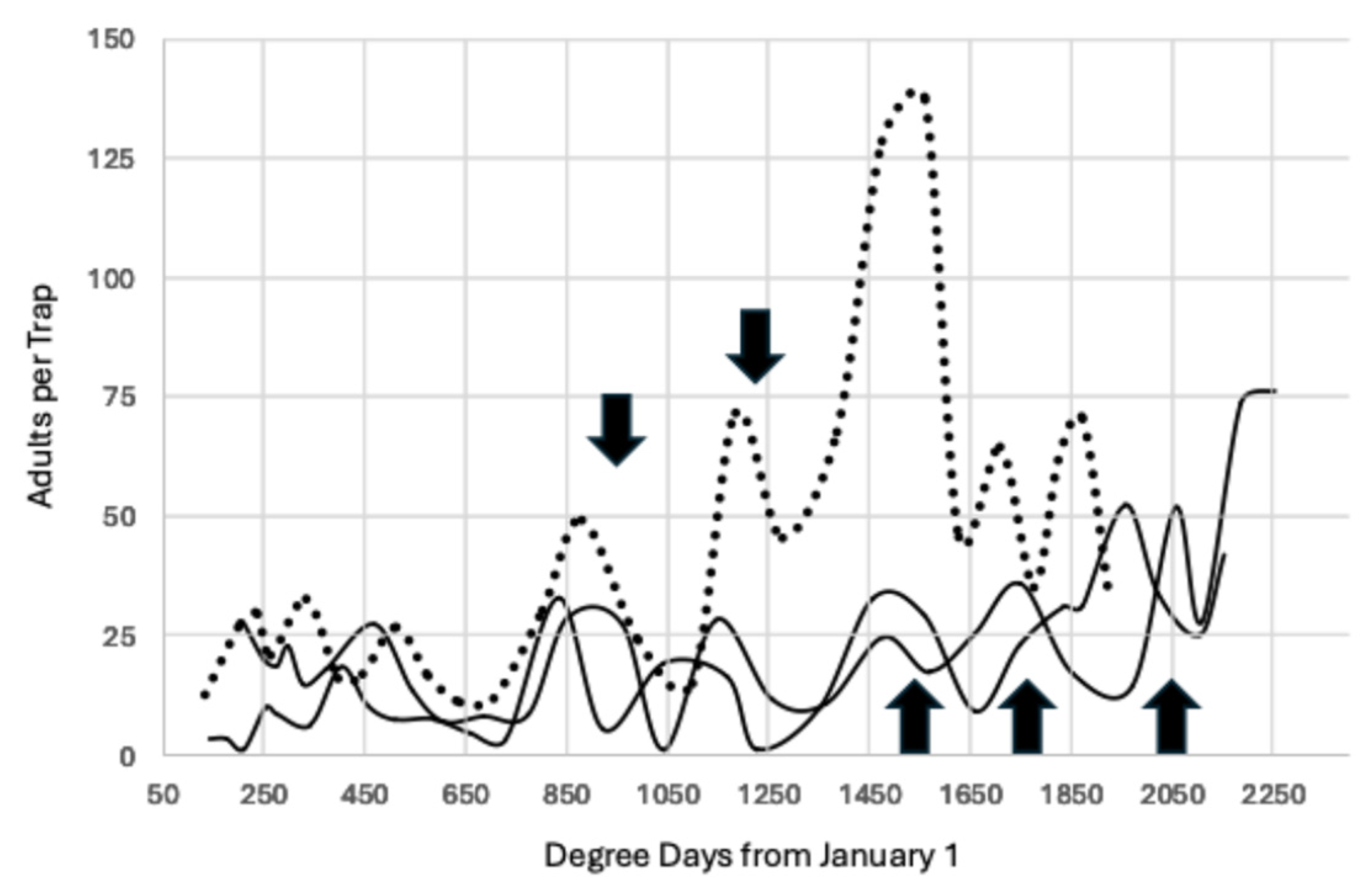
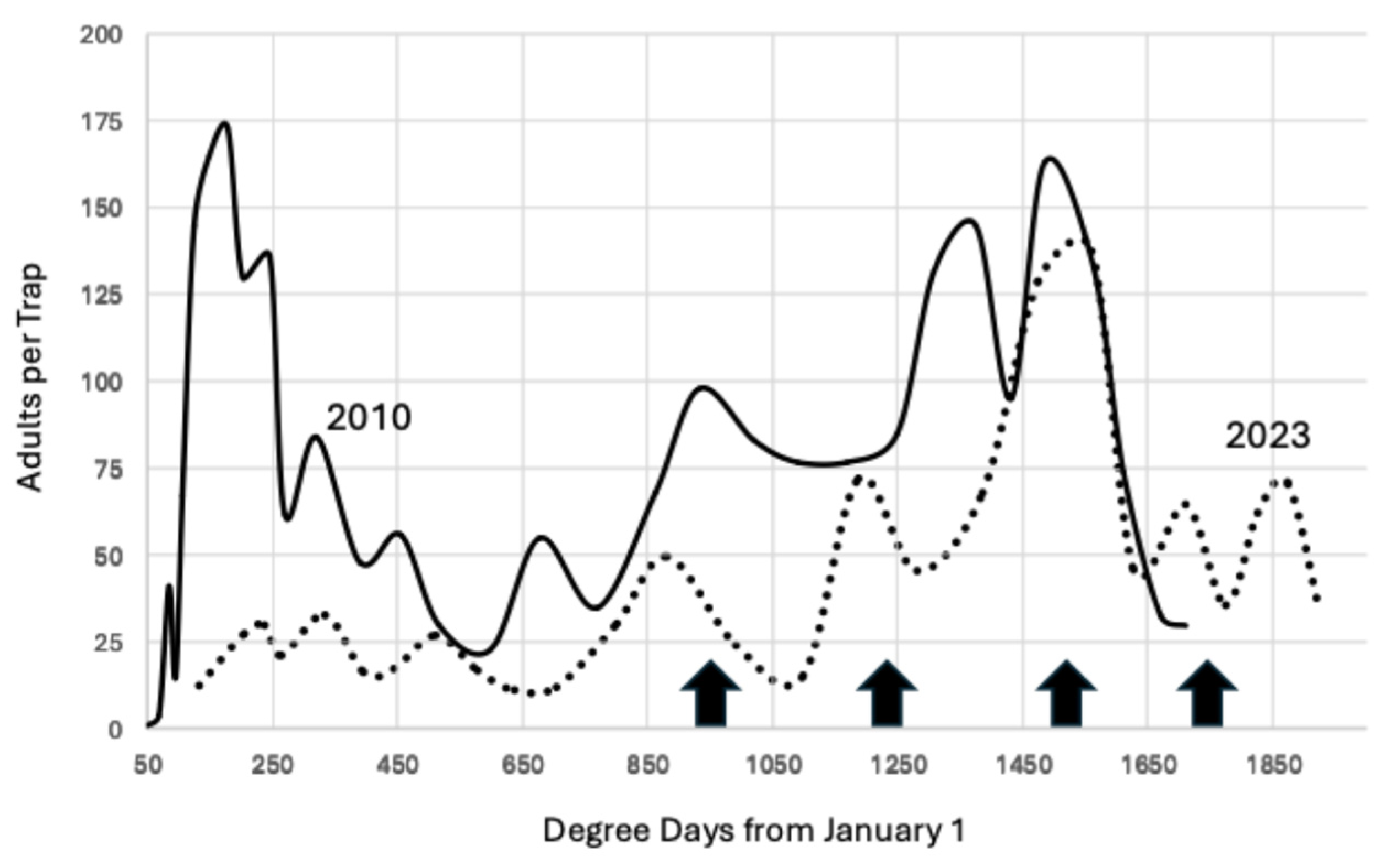
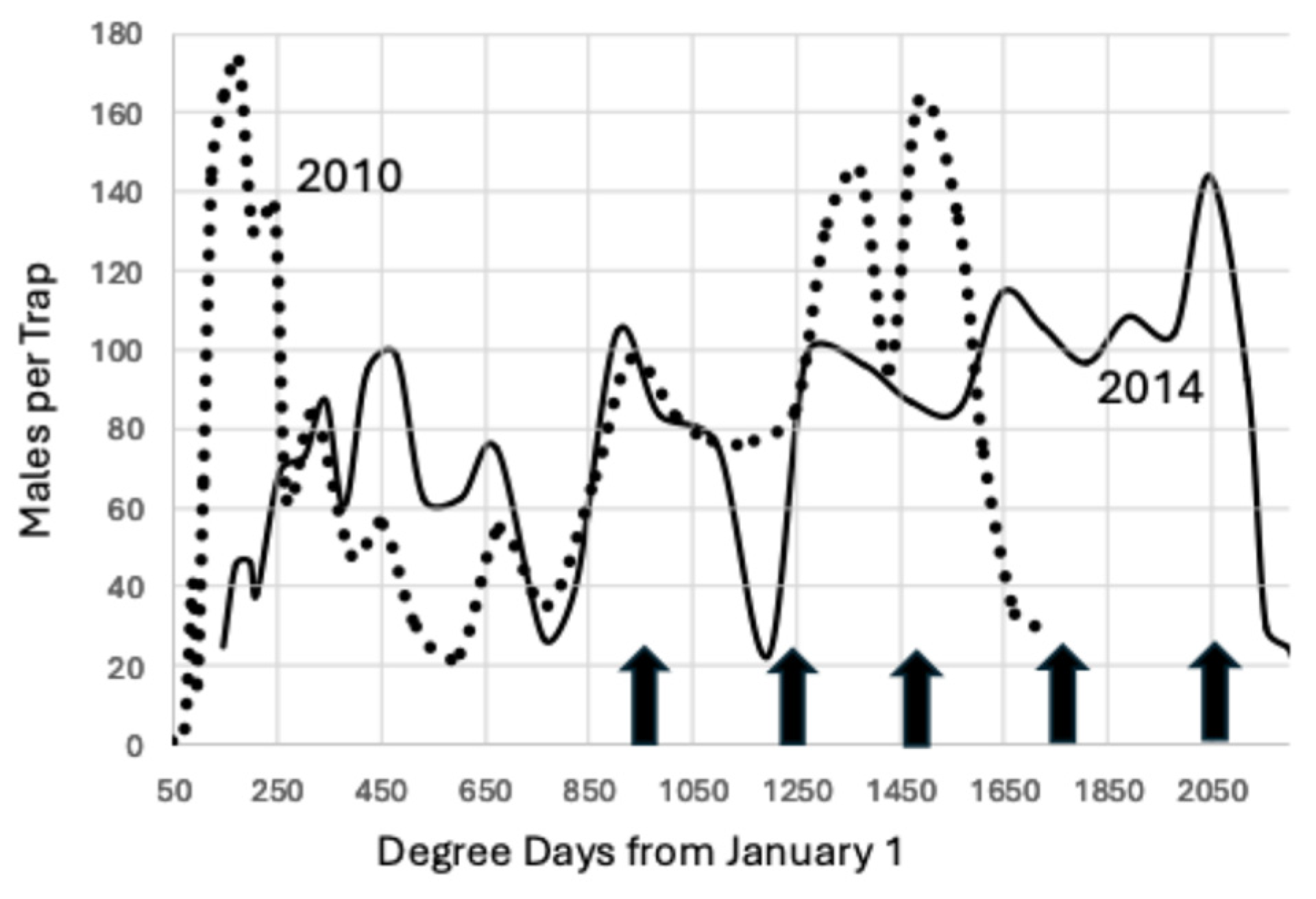
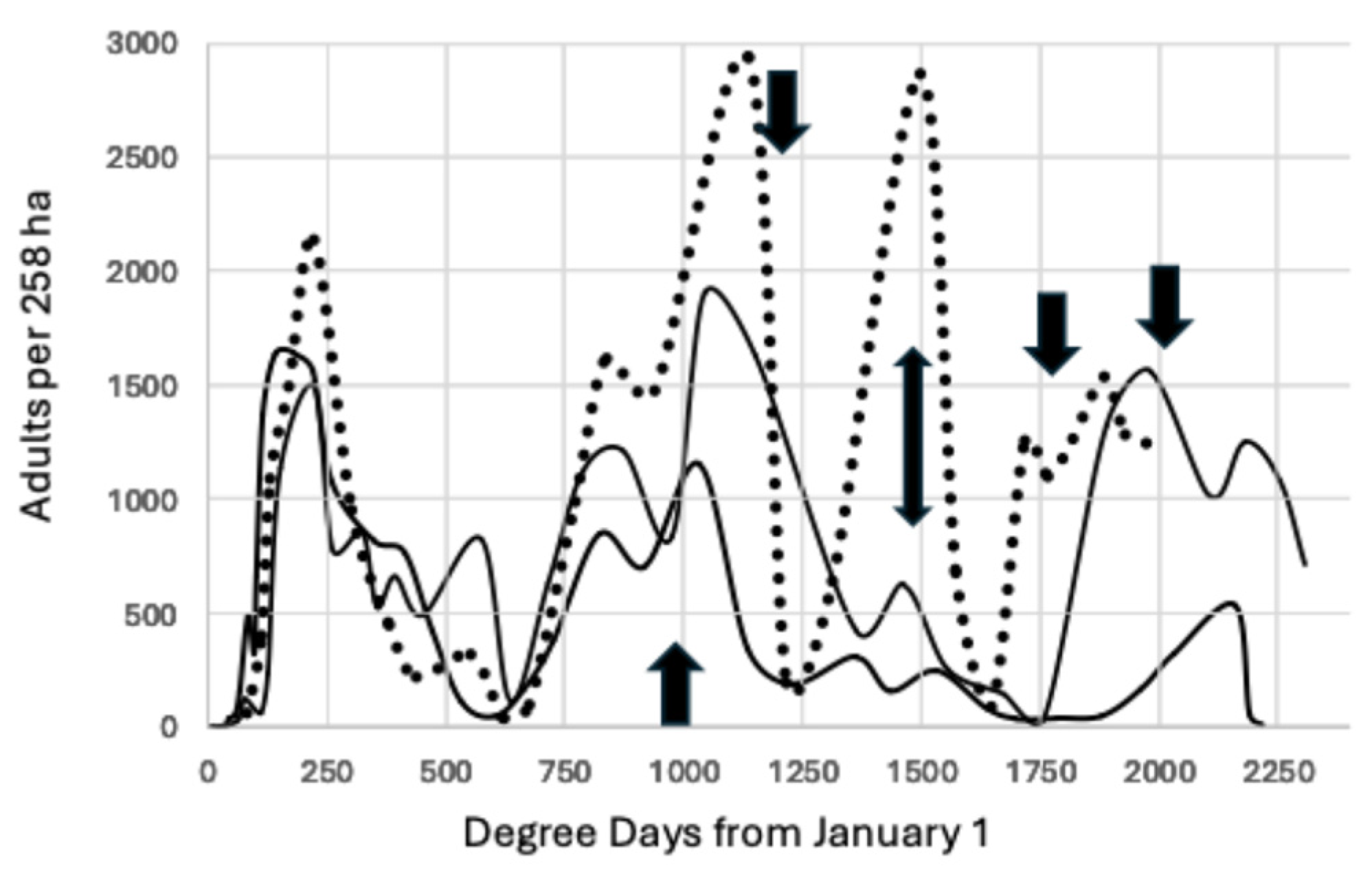
| Years | July | August | September | October |
|---|---|---|---|---|
| 2008–2015 | ||||
| 23.8 ± 7.2 | 26.7 ± 9.1 | 33.6 ± 6.3 | 16.0 ± 10.7 | |
| 2021–2023 | ||||
| 10.1 ± 8.5 | 28.0 ± 8.5 | 45.1 ± 5.9 | 16.3 ± 6.1 |
| Years | 944 DD | 1222 DD | 1500 DD | 1778 DD |
|---|---|---|---|---|
| 2008–2011 | 946.8 ± 38.0 | 1218.0 ± 48.4 | 1500.3 ± 21.4 | |
| 2012–2015 | 940.6 ± 48.0 | 1234.2 ± 39.1 | 1465.0 ± 14.8 | 1785.2 ± 35.4 |
| 2021–2023 | 958.8 ± 33.8 | 1203.9 ± 48.7 | 1470.6 ± 9.3 | 1735.1 ± 21.7 a |
| 2021–2023 b | 946.0 ± 27.8 | 1232.0 ± 82.0 | 1496.7 ± 33.0 | 1726.3 ± 58.0 a |
Disclaimer/Publisher’s Note: The statements, opinions and data contained in all publications are solely those of the individual author(s) and contributor(s) and not of MDPI and/or the editor(s). MDPI and/or the editor(s) disclaim responsibility for any injury to people or property resulting from any ideas, methods, instructions or products referred to in the content. |
© 2024 by the author. Licensee MDPI, Basel, Switzerland. This article is an open access article distributed under the terms and conditions of the Creative Commons Attribution (CC BY) license (https://creativecommons.org/licenses/by/4.0/).
Share and Cite
Siegel, J.P. The Flight Pattern of Navel Orangeworm (Amyelois transitella Walker) 2008–2023 in California Pistachio. Insects 2024, 15, 919. https://doi.org/10.3390/insects15120919
Siegel JP. The Flight Pattern of Navel Orangeworm (Amyelois transitella Walker) 2008–2023 in California Pistachio. Insects. 2024; 15(12):919. https://doi.org/10.3390/insects15120919
Chicago/Turabian StyleSiegel, Joel Philip. 2024. "The Flight Pattern of Navel Orangeworm (Amyelois transitella Walker) 2008–2023 in California Pistachio" Insects 15, no. 12: 919. https://doi.org/10.3390/insects15120919
APA StyleSiegel, J. P. (2024). The Flight Pattern of Navel Orangeworm (Amyelois transitella Walker) 2008–2023 in California Pistachio. Insects, 15(12), 919. https://doi.org/10.3390/insects15120919






